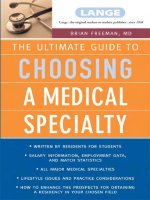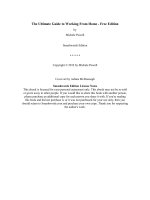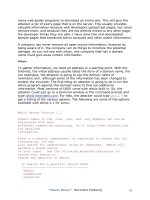The ultimate guide to personal safety on ships
Bạn đang xem bản rút gọn của tài liệu. Xem và tải ngay bản đầy đủ của tài liệu tại đây (9.11 MB, 91 trang )
The Ultimate Guide to
Personal Safety
on Ships
www.marineinsight.com
Marine Insight©
The Ultimate Guide to Personal Safety On board Ships
First Edition
Publication date February 2012
Authors: Anish Wankhede and Raunek Kantharia
Published by: Marine Insight
www.marineinsight.com
Graphic Design: Anish Wankhede
(copyright symbol) Copyright 2012 Marine Insight
NOTICE OF RIGHTS
All rights reserved. No part of this book may be rewritten, reproduced,
stored in a retrieval system, transmitted or distributed in any form or
means, without prior written permission of the publisher.
NOTICE OF LIABIITY
The authors and editors have made every effort possible to ensure the
accuracy of the information provided in the book. Neither the authors
and Marine Insight, nor editors or distributors, will be held liable for any
damages caused either directly or indirectly by the instructions contained
in this book, or the equipment, tools, or methods described herein.
Join Marine Insight on
About this eBook
Authors’ Acknowledgement
While writing this e-book, we have considered that safe practices
are not only for engine or deck crew but also for each and every
person who boards the ship or sails with the same.
Marine Insight is extremely thankful to all the maritime
professionals who have provided their insights for making
this book.
It doesn’t matter if you belong to deck, engine, or galley
department, when safety of the crew and the ship is at stake, a
well planned team effort is what helps to overcome or fight an
emergency situation.
We are also grateful to all the chief engineers and captains for
the constant support and encouragement they have provided
us to write this book.
For a ship to operate safely at the sea, team effort is of utmost
importance. However, the first step towards safety starts with the
individual and therefore personal safety is imperative.
In this e-book, you will understand the basics and importance of
personal safety along with the right methodology to approach
and implement safety in your work on ships. Also find out how
as an individual you can stay away from trouble on ship,
ensuring not only your own safety but also of the whole ship.
We would also like to thank all our team members at Marine
Insight for working with immense patience and showing great
enthusiasm.
Last but not the least; we thank all Marine Insight readers for
showing their love and interest, which inspire us each day to
deliver our best!
Dedicated
To
This e-book has been divided into 6 chapters, which cover each
and every aspect of personal safety with extensive details.
Seafarers at the Sea
If you like this eBook, please feel free to share it with your
friends.
- Anish Wankhede & Raunek Kantharia
Salute to all!
Content
1. Why personal safety should be the first priority on
ships?
(Page no.: 1 – 24)
2. Personal safety- Your first step on ship
(Page no.: 25 – 50)
3. Personal safety in every part of the ship
(Page no.: 51 – 80)
4. Personal safety in ship’s operations
(Page no.: 81 – 126)
5. How to use special personal protective equipment
on ships?
(Page no.: 127 – 142)
6. Miscellaneous safety tips & resources
(Page no.: 143 – 156)
Chapter 1
Why personal safety should be the
first priority?
Why safety is so important?
How to develop the right attitude towards personal
safety?
What all things are included in personal safety?
What all things you should know before boarding the
ship?
Share This E-book
Why Safety at Sea is a Matter of Utmost Importance?
According to the International Maritime Organisation (IMO),
“Shipping is perhaps the most international of all the world’s
greatest industries and one of the most dangerous.”
To understand the role and importance of safety in a shipping
organization or process, we will take help of the “Safety
Triangle.”
This means that in shipping industry even the most basic job of
transporting cargo across oceans involves great amount of risk,
involving both physical and financial aspects.
Human well being
Every part of the shipping business is bounded by stringent
regulations, which prompts companies to act in disciplined and
organized manner.
To ensure that all operations are carried out in an efficient and
smooth manner at the sea, the shipping companies resort to
“safety” as their first tool for streamlining processes.
Safety in all types of operations is the key factor in ensuring that
the company always maintains its position about the profit line,
both efficiently and ethically.
Clean Sea
SAFETY
TRIANGLE
Commercial Success
Costa Concordia figure
“Carnival Corp., parent company of Costa Cruises, said that the partial
sinking of Costa Concordia cruise ship off the coast of Italy could cost
it nearly $100 million in lost earnings”.
When the “Safety Triangle” was compromised in the operation of the Costa
Concordia cruise ship, it led to the loss of life, property, and environment.
1
2
When a shipping company operates under safety norms, three things (mentioned in the safety triangle) rank at the top of their priority lists:
Personal Safety
Personal safety or safety of life at sea comes at the top of priority
list as there is no loss which is considered greater than the loss of
human life. Shipping companies understand the importance of
the safety of human life at the sea and thus rank it at the very top.
It’s a known fact that without an efficient crew no shipping
company can survive.
Marine Environment Protection
While operating in both domestic and international waters, no
shipping company can exclude marine environment protection
from its business plan. Safety of marine ecosystem can be
ensured by efficient operating conditions on ships to
avoid pollution by oil spills, garbage dumping etc.
Commercial Success
Technically, a shipping company can achieve commercial
success when the first two aspects of the “safety triangle” are
taken care of. An efficient operation of the ship, without any
kind of harm to human life or environment saves shipping
companies a lot of time, money, and labour, which ensures
growth and profitability in return.
3
Join Marine Insight on
4
How to Develop the Right Attitude to Attain
The Ultimate Personal Safety on Ships?
When we talk about personal safety, it is important to understand
that just by providing the right safety equipment to seafarers a
safe working environment cannot be created.
It is only through persistent self motivation and training can a
seafarer develop the right attitude towards on board safety.
You can provide long hours of training and seminars to ensure
that the crew knows and understands all the safety features of
your ship. However, do note that this would not guarantee a
secure working environment.
Unless seafarers realize the importance of safety, hours and
hours of training imparted on safe working practices wouldn’t
bring any results.
So how does one develop the right attitude to attain the ultimate
personal safety on ships?
As a seafarer, it is extremely important that the duties onboard
ships are performed with an utmost conscious mind in order to
avoid any kind of harm to the crew or the ship.
But the attitude to keep an agile mind doesn’t come on its own.
Moreover, no one is going to stand by you forever to make sure
that all duties are performed articulately along with the right
safety measures.
5
Every person has a safety conscious mind; however, many a
times we avoid safe practices just to get over with the job quickly
or are too lazy to follow additional safety procedures. Such
attitude needs to be shunned!
“SAFETY IS A STATE OF MIND — ACCIDENTS ARE
AN ABSENCE OF MIND”
There is a need to develop safer habits to overcome our “slack
attitude” towards safety and to make our working environment
safer and secure. Only through consistent practice can one form
the right mind set to inculcate safe working procedures.
6
Ultimate personal safety can be said to have achieved when safe
working habits become an integral part of one’s reflexes rather
than self-initiated actions.
For example, if a ball is thrown at your face, your hands will
automatically move to stop the ball. This is known as a reflex
action. When such reflexes take form of safe practices and
become an inherent part of a seafarer’s working behaviour, the
ultimate personal safety attitude is said to have achieved.
This natural instinct of a safety conscious mind is the key factor
for developing the right attitude in seafarers. Disciplined
working procedures and consistent practice are the two aspects
which play a major role in achieving the right mind set.
You might have undergone rigorous safety trainings and
seminars on land; but do note that practicing on shore is one
thing and putting what you have learnt in real life scenario on
ships is a totally different ball game.
To make sure that you maintain a certain level of safety while
working on ship, there is a universal checklist which you need to
follow. It is called “The 5 Point Personal Safety Checklist”
To ensure that you take the right course towards personal safety,
follow these 5 important checks before carrying out any
operation or work on ships:
Awarerness of Your Surroundings
In Box – The 5 Point Personal Safety Checklist
Now we know that a trained mind is the key to achieve an
ultimate personal safety environment. Having said that, how do
we know our working practices are absolutely safe or not?
?
Calculation of Risk- Includes surety and suspicion
Work on Risks before Working on the Job
Checking Your Personal Protective Equipment (PPE)
Escape Route
7
8
Awareness of Surrounding
The first and most important step towards personal safety on
ships is to be aware of your surroundings. Awareness of
surroundings includes knowing your working space, risks and
hazards present around you, and assessing the amount of efforts
the job would require. This would allow you to plan your job
safety and efficiently.
Calculation of Risk- Surety Vs Suspicion
After having a complete look of your surroundings, including
risks/hazards, check the extent of harm any kind of accident
in that particular area can cause you. This is to calculate the
amount of risk involved with the work. Always note that the
amount of risk involved with any job on ship is always
greater than what you would have calculated. Also, if you are
suspicious that a particular procedure involved in the job
might lead to an unfavourable outcome, stop right there.
Make sure you weigh your doubts properly before
commencing the job.
Work on Risks before Working on the Job
It is always better to find out the amount of risk involved with
the job before getting into it. Eliminate or minimise as many
hazards as possible from your working place before carrying out
your assigned job. Note that it is not possible to make any job
cent percent risk free; however, minimizing the number of risks
involved would drastically increase your level of personal safety.
9
10
Checking Your Personal Protective Equipment (PPE)
Personal protective equipment on ships provides you with
tools to enhance your safety on board. Ensure that you are
using the right personal safety equipment as required by
the job. It is also imperative that you know the operation
and working of all safety tools on board ships. In
emergency situation, these tools are your lifelines, which
would get you out safe and secure.
Escape route
Escape route is the last resort you would seek in case all
measures to curtail an accident fail.
Note that ships comprise of several machines, pipelines, and
complex systems (Pneumatic, hydraulic, electrical, and
electronics) running at extremely high working parameters. This
makes the ship an extremely hazardous environment to work in.
While working on ship, trouble always comes uninvited and you
must be prepared for the same. Sometimes, in spite of following
all the safety measures, things might go wrong.
For such situations, always pre-plan your exit-strategy from your
working place through the easiest and fastest route possible.
11
12
What all things are included in personal safety?
1 Follow Safety Policies: Every company has its own safety
5 Help Yourself First: When you and your colleagues are trapped
policy as per the rules of SOLAS (ISM code). It is imperative that
seafarers not only understand and follow these safety points but also put
them into practice while working on ships.
in a dangerous situation, help yourself first to get out of the situation, and
then help others. Don’t try to help others unless you are confident about
your own wellbeing. This would ensure safety of both you and your
colleagues.
2 Situational Awareness: Awareness of any
6 Know Your Ship Inside-Out: On joining a
situation involves knowing your surroundings and
working environment to analyse the amount of risks
involved with a particular job, and to figure out ways to
tackle problems, in case any arises.
new ship, seafarers should familiarise with every
nook and corner of the ship, including location of fire
fighting appliances, life saving appliances, alarms,
escape routes, life boats, and everything else that
would help them in an emergency situation.
3 Knowhow and Training: Correct operating
7 Know Your Emergency Duties: Every crew
knowledge of different equipment tools and systems on
ships, including safety procedures and emergency plans
must be gained through proper training and practice.
member should know what to do and how to do it in
case of an emergency situation. Knowing one’s duties
would ensure personal safety along with the safety of
the crew, the ship, and the environment.
8 Avoid Panic Attacks: It is human to get tensed or
4 Use of PPE: Every person onboard ships must know what
nervous in case of an accident. However, one should know ways
to control emotions, to maintain mental peace, and to act in a
quick and smart manner under the pressure of an emergency
situation.
personal protective equipment to be used and when. This includes
every detail involved with procedure of donning, checking, and
operating PPE.
13
Things to do before boarding a Ship
Step
Onboard
Healthy
Stay Fit
Know
Local Laws
Vaccination
Safety
&
Training
Insurance
Leave
Valuables
At Home
Anti Piracy
Training
Know
Your Ship
… Route
14
1. A Fit Seafarer, a Safer Ship – Stay Fit
Make sure you are absolutely fit both physically and mentally
before boarding a ship. If you are suffering from any kind of
ailment, don’t go to the ship without getting it cured.
Remember that there is no specialised medical assistance at the
sea, and thus you need to be extra careful as far as your health is
concerned. Moreover, if you are required to carry any kind of
medication to the ship, inform your company’s doctor about your
current health condition and take a prescription to carry
medicines along with you.
2. Pre-Familiarize Yourself with Local Conditions and Laws
Different countries have different laws and it is imperative to
follow all the rules and regulations under those laws. For e.g.
pirated DVDs are not allowed at Singapore airport,
movies/photographs with explicit content are banned in Gulf
countries etc.
These are just a few of the several lesser known laws of
different countries around the world. Enquire about the
presence of any such law in the countries you are about to visit
to avoid trouble on foreign land.
15
16
3. Don’t Just Attend Training Courses, Get Actively Involved
Training courses and seminars are conducted by companies to
make sure that seafarers are thoroughly prepared before
joining a ship. Every person joining a ship should pay extra
attention to STCW courses and safety training sessions.
Note that extensive information provided during such sessions
is not made available again during the whole tenure of one’s
sailing contract. It is therefore important that a seafarer
absorbs and retains maximum knowledge imparted during
those sessions to increase his or her level of personal safety on
ships.
4. Anti Piracy Training- Need of the Hour
Piracy at sea is at its all-time-high. With hundreds of piracy
cases reported every year, the issue has become a matter of
grave concern. If the ship you are about to join has its route
through one of the piracy sensitive areas, it is imperative that
you make yourself aware of ways to tackle pirates at the sea.
In case the company doesn’t provide any information, one
should personally approach the management of the company
and request to arrange for an anti piracy training course or to
provide guidelines and knowledge for dealing with such
adverse situations.
17
18
5. Know the Route of Your Ship
Ask your company about the shipping routes and ports which the
newly assigned ship will be visiting during its voyage. This is to
get prepared for any kind of adverse weather conditions.
For e.g. you would be required to carry appropriate weather
protective gear to save yourself from fierce cold or scorching
heat.
The ship is liable to provide all personal protective equipment
(PPE) as soon as you board the ship; however, one must carry
important weather protecting gears such as parka, muffler etc. to
the ships.
6. Keep Valuables at Home
Leave all those things, which you would hate to lose, at home.
There are high chances of losing valuable things while
travelling or on board ships. Stealing on ships is a common
thing especially when the ship is at ports.
19
20
7. Get the Necessary Vaccination and Medical Insurance
Check your personal medical insurance papers and get all the
necessary vaccinations before boarding a ship. If you have to
carry medicines, get the necessary prescriptions as several
countries do not allow carrying medicines without perceptions.
Though a company would cover all the medical expenses in
case of an accident or ailment, it is always advisable to have
your own personal medical insurance to avoid any kind of
delay in medical procedures.
8. Know all the points to stay healthy on ships
Personal safety always starts with a healthy body. Few issues
are not addressed during safety training and seminars
conducted before joining a vessel. A seafarer should gather
knowlege on these issues before boarding a ship.
Working on a ship means dealing with adverse climate
conditions and hostile working environments. To survive
through tough working surrounding, one must stay healthy and
fit. Find out how to keep your mind and body healthy on
ships.
21
22
Seasickness is a common situation faced by seafarers on ships.
One should know about seasickness along with ways to fight the
same. Read here to find out A-Z of seasickness.
A seafarer should also have knowlege about other important
issues such as:
seafarers and the issue of sexually transmitted diseases
(STDs)
Stress on ships and ways to avoid it on board ship
Methods to avoid monotony on ship
Harmful effects of drinking seawater
Types of maritime crimes,
Hypotermia and its effects on seafarers
“Ship is like a floating factory full of
risk, make sure you are well prepared
before boarding it”
Join Marine Insight on
23
24
Chapter 2
Personal Safety-Your First
Step on Ship
What all things you need to know the moment you
step on board?
First thing first – checklists
Developing the right attitude once aboard
10 Benefits of acting and behaving responsible
Share This E-book
Things to learn as soon as you step on board ship
A seafarer becomes vigilant about the importance of safety the
moment he or she steps on board ship. Every careful step a
seafarer takes while climbing the shaky gangway of the ship
invokes a kind of realization, which instils the fact that the place
he is boarding requires additional awareness to stay safe and
secure.
In fact the words “SAFETY FIRST”, stencilled on the bulkhead
of the ship in large fonts, would be the first thing anyone would
notice as soon as he or she steps on a ship - It is a way of
reminding the importance of safety to anyone boarding the ship.
Every operation on ships starts with taking appropriate safety
measures. When you join a ship as a new crew member, it is
your responsibility to take initiatives to learn about all the safety
procedures and features that are important on board ship.
And your first step towards safety starts from your
accommodation or cabin itself. Things you should do are:
25
1. Check your Accommodation
The first place you would visit on board a new ship is the cabin
or the accommodation area. Your safety checks start from your
cabin. Do the following:
- Check if life jacket and immersion suit are kept in their
designated lockers in your cabin.
- Check all fittings, accessories and condition of jacket and
suit.
- Check the location of the nearest fire extinguisher from
your cabin
- Check the emergency escape located nearest to your cabin
- Check the location of Emergency Escape Breathing
Device (EEBD)
- Check your duties posted in the Muster list along with
your lifeboat station
- Check the nearest fire hose in the accommodation area
- Check ship’s alarm description in the muster list
- Check location of alarm button near to your cabin
- Check your cabin thoroughly for presence of any
unidentified object
26
2. Check the General Layout of your ship
When emergency strikes, time is one thing which is extremely
precious. To save maximum amount of time, every seafarer
must know the complete layout of the ship, along with the
way to reach the muster station from any part of the ship.
Familiarise yourself with the general arrangement plan of
your ship by visiting and exploring every accessible corner.
Do the following things:
- Check the general layout of your accommodation from
each deck
- Check different ways to approach the muster station
- Check forecastle of the ship and arrangements of escape
routes provided
- Check location of life raft and lifebuoy provided at the
forecastle
- Check aft part of the ship and arrangement of escape
routes provided
- Check location of lifebuoys in other parts of the ship
27
Check Your Work Space
When on ship, a seafarer spends maximum of his or her time at the work place. No matter what your workplace is - deck, engine room, bridge,
or galley, ensure that you take every possible precaution to stay safe. Check the following things thoroughly. (Checks for both engine and deck
side have been provided)
Engine Room Checks
- Check if life jackets and immersion suits provided in the
engine room are in proper condition and well in number
- Check EEBD in the engine room
- Check Medical First Aid Box
- Check emergency escape routes from the engine room and
also find out where it leads on the deck
- Check all the life saving appliances for their starting and
stopping procedures, including those of emergency
generator, lifeboats, emergency compressors, and
emergency fire pumps.
- Check all engine room machines for abnormal operations
- Check location of water tight doors and their operation and
working
- Check location of fire hoses and fire hydrants
28
Deck Side Checks
- Check gangway of the ship for proper lifting and lowering
arrangement
- Check net and railing in the gangway
- Check all the railings and freeways on the deck
- Check all life saving appliances provided on the deck
- Check location of fire hoses and fire hydrants
- Check location of fire plan
- Check location of international shore coupling and
connection
- Check fire line on deck with main valves
- Check the bunker station on deck for remote stopping of
pumps.
29
Bridge Checks
-
Check location of lifejackets and immersion suits
Check EEBD location on bridge
Check location of lifebuoy
Check location of nearest fire extinguisher
Check location for storing EPIRB and SART
Check location of emergency fire pump switch
Check location of distress signal button on bridge
Check emergency escape route from bridge and ways to
approach the muster station
Galley Checks
-
Check location of the nearest fire extinguisher
Check location of fire blanket
Check location of fire alarm button
Check location of fire damper
Check location of nearest fire hose
Check location of nearest escape route and ways to
approach muster station from the galley
- Check all electrical plugs and fitting for overheating or
burning
- Check all equipment for safe and accidental free operation
Join Marine Insight on
30
Miscellaneous Checks
Apart from the mentioned places, there are few other
important rooms/ sections on the ship which must be checked
during the first few days of joining the ship.
Do the following:
- Check fire station on ship and different equipment and
systems provided for the same
- Check IMDG locker onboard and safety equipments
provided
- Check location of CO2 fixed system on ship
- Check location of chemical locker on ship, along with
safety PPEs and material safety data sheet (MSDS )
- Check the location of SOPEP locker and tools therein
If you are
confused about
your own decision,
you will lose
precious time in
an emergency
situation. Know
your ship well.
31
Checklists and Forms
Every operation conducted on a ship is bounded by a checklist or
a form (or both). These tools ensure that no safety measure is
overlooked while carrying out a job on ships.
Shipping companies are extremely cautious when it comes to
these forms and checklists. It is therefore imperative for every
seafarer to learn about these important procedures to enhance
their own personal safety.
Technically, there are several of these checklists and forms on
ships which are to be referred and filled before carrying out
different operations. Each of these procedures should be
thoroughly understood for averting any kind of trouble.
To ensure that all necessary steps are taken by seafarers for their
personal safety, forms and checklists are filled and filed for later
reference.
As soon as a seafarer boards a ship, following forms, checklists,
and safety manuals have to be signed.
32
33
Forms
Pre Familiarisation Form: Some companies advise their crew
to complete a pre familiarisation form within 24 to 48hrs of
joining the ship. When signed by the new seafarer, this form is a
written proof that an officer of the vessel has provided
familiarization of different parts and safety systems of the ship,
including muster station, lifeboats, and life raft location.
Personal Duty Form: A personal duty from is provided to the
seafarer stating general duties onboard ship according to the
rank, duties to be performed during different emergency
situations such as oil spill, fire, grounding etc., and duties at the
muster station and assigned lifeboat.
Department Familiarisation Form: A separate familiarisation
form has to be presented by the seafarer within 15 days of
joining a ship, in order to validate that he or she has completely
understood the safety equipment, procedures, and systems of the
ship, including engine room, deck/bridge, and galley. A senior
officer is responsible to familiarise the newly joined seafarer
with various systems of the ship.
Marpol Declaration Form: Some companies are extra cautious
when it comes to marine environment. To prevent any kind of
involvement in marine pollution activity, shipping companies ask
seafarers to sign a Marpol declaration form, which states that you
are aware of all the pollution regulations at sea and are liable to
be suspended along with legal actions if any kind of marine
pollution results from your mistakes.
34
35









